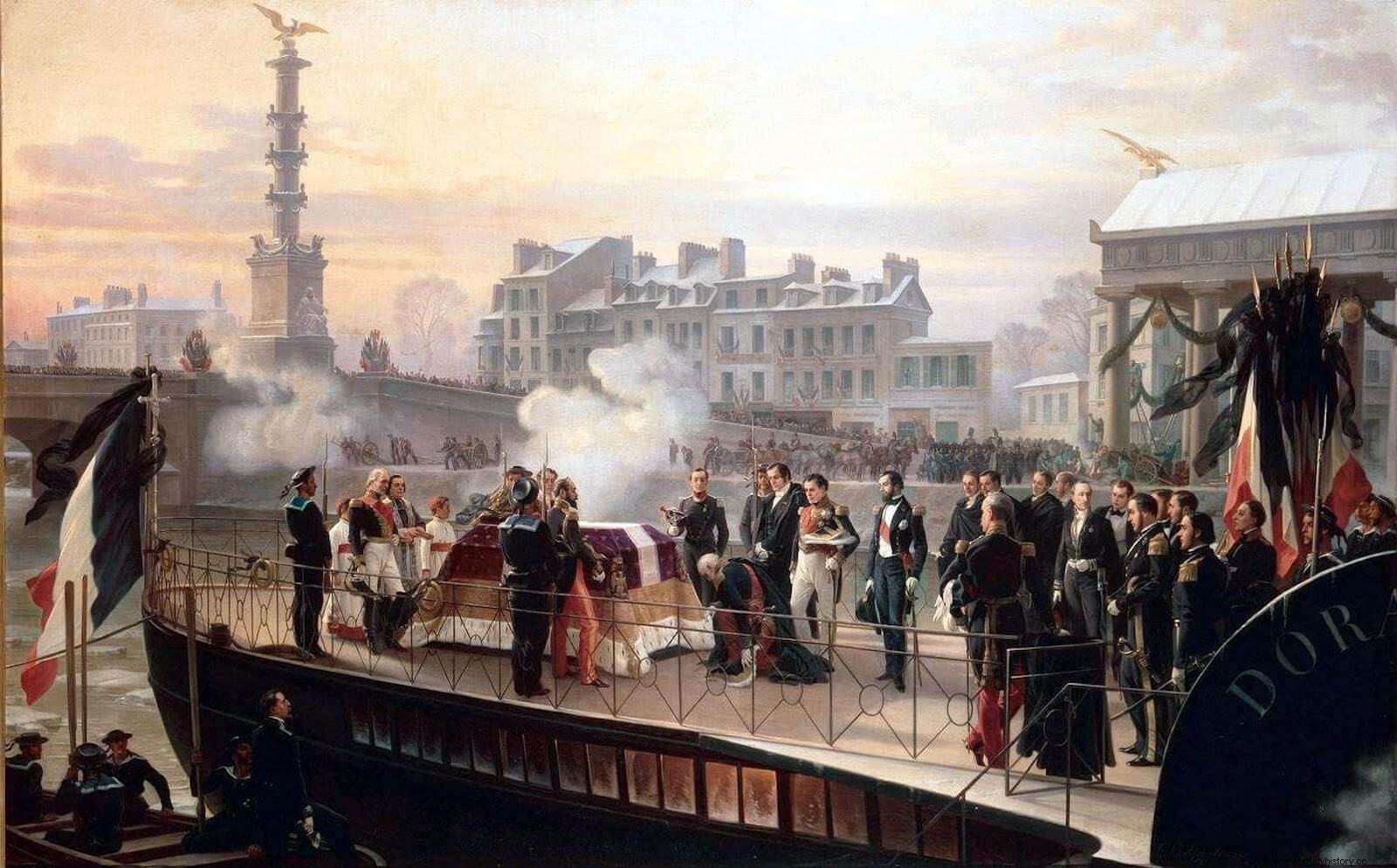
The immobile and repressive policies of the Bourbons during the Second Restoration provoked growing unease among broad layers of French society, despite the fact that the new enthronement meant the conclusion of a cycle of twenty years of wars that had ruined and bled France, placing it under the tutelage of the signatory powers of the new order. European at the Congress of Vienna. The return of the nobles meant the dismissal from the army of a large number of officers with long careers behind them who found themselves retired with half pay, confined in many cases to their places of origin and subject to inconspicuous police surveillance. The démi-soldes they were the first agents of the revival of Napoleon's prestige , supported by the convulsions in the working-class neighborhoods due to the collapse of wages as a consequence of the demobilization of the army and the preference of industrialists to employ women and children as cheap labor. In addition, the return of the land to the emigrants after the Revolution of 1789 caused a decline in support for the monarchy in rural areas, and the period of the Napoleonic government began to be considered by many as a golden age due to the social and economic transformations that established a large part of the revolutionary ideas. For this reason, the Emperor began to be described as “the father of the people”. In addition, the industrial and commercial bourgeoisie, enriched during the Empire, whose members had reached positions of responsibility in the administration and the legislative body, saw their social position suffer from the return of absolutism, especially after the rise to power of Charles X. The colored images of the Napoleonic campaigns and the editions of the copies of the Bulletin de la Grande Armée They became referents that promoted the legend and the resurgence of the figure of the Emperor.
The debate over Napoleon's return
The July Revolution of 1830 , in whose combats a large number of former imperial soldiers participated, ended the Bourbon dynasty in France, and the new monarch, Louis Philippe of Orleans, aware of the strength of the Bonapartists in society, ordered, as a symbolic measure of recognition, the replacement of the statue of Napoleon at the top of the Column in Place Vendôme, news that Letizia Ramolino commented on in Rome indicating:"The Emperor is back in Paris!" However, a proposal for the new government to demand the return of Naoleon's mortal remains to be buried at the foot of the Column was rejected by parliament on October 2, 1830. The July Monarchy, although liberal and open to the bourgeoisie, was in fact as conservative and immobile as the Bourbon, and Luis Felipe himself was traumatized by the execution of his father during the Revolution, the imprisonment of his brothers, and the long years of exile he had to face between 1793 –when he went over to the enemy together with his boss, General Charles François Dumoriez (1739-1823)– and 1814, and later between 1815 and 1817.
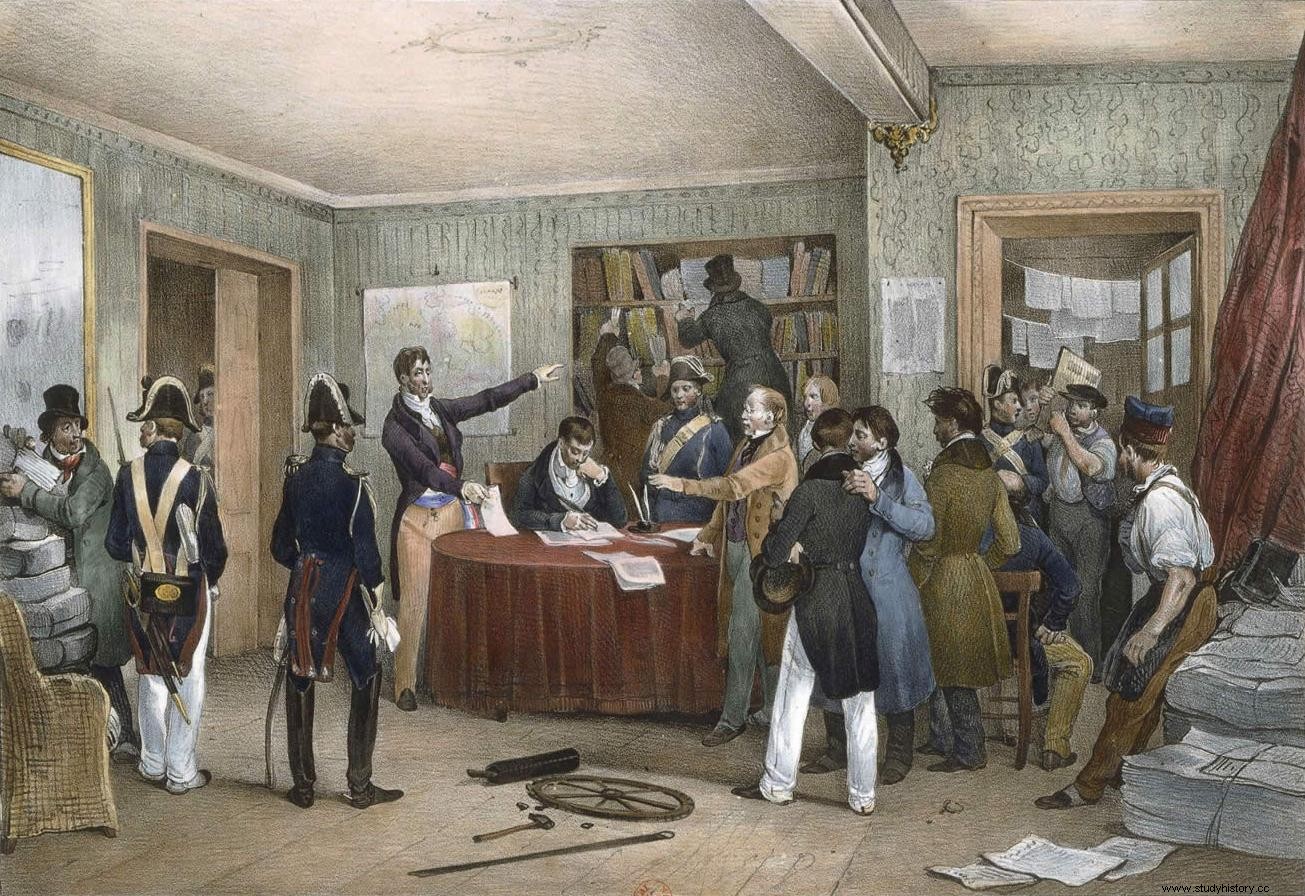
Therefore, when the president of the Council, the historians of the Revolution and the Empire Adolphe Thiers (1797-1877), proposed to the king in May 1840 to request the British government the return of the remains (le retour des cendres) of Napoleon , the king and his family were initially opposed, and only ultimately accepted Thiers's idea when he explained that it was a political move by which France would recover the lost periods of glory while also obtaining the political support of the Bonapartists and of wide sectors of the liberal bourgeoisie that considered the Empire as a reference. Luis Felipe's fears that the measure would in fact represent a resurgence of Bonapartism as a political option were confirmed when Interior Minister Charles de Rémusat presented the project to the Chamber of Deputies on May 12:
The response of the deputies was enthusiastic and a credit of one million francs was approved, destined solely for the organization of the funeral services upon arrival of the remains which, despite the previous requests for burial in Place Vendôme and in those made in 1840 for him to be buried in the pantheon of the kings of France in Saint-Denis, it was decided that they be deposited in the Les Invalides compound , not only to individualize him, but to enhance the memory of him as a military leader and differentiate his government from absolutism. However, the favorable reaction, although the majority, was not unanimous, and when General Clauzel -one of those mentioned by Napoleon in his will- presented the characteristics of the return project to the Chamber, some voices were raised against among which The writer and politician Alphonse de Lamartine (1790-1869) will stand out, who refused the civil canonization of whom he considered an enemy of freedom:
Once permission was obtained from the British Government, Francisco de Orleans, Prince of Joinville (1816-1900), despite his refusal to act as "undertaker", was entrusted with the direction of the delegation that left the port of Toulon on July 7, made up of the frigate La Belle Poule and the corvette La Favorite, and which included Generals Bertrand and Gourgaud, Emmenuel de Las Cases, son of the memorialist, and Saint-Denis (Alí), as well as the surviving Longwood servants. The journey to the South Atlantic was delayed for more than three months due to Joinville's lack of interest in the mission. When the ships arrived at Santa Elena on October 8, Governor George Middlemore (1756-1850) determined that the remains would be returned on the 15th.
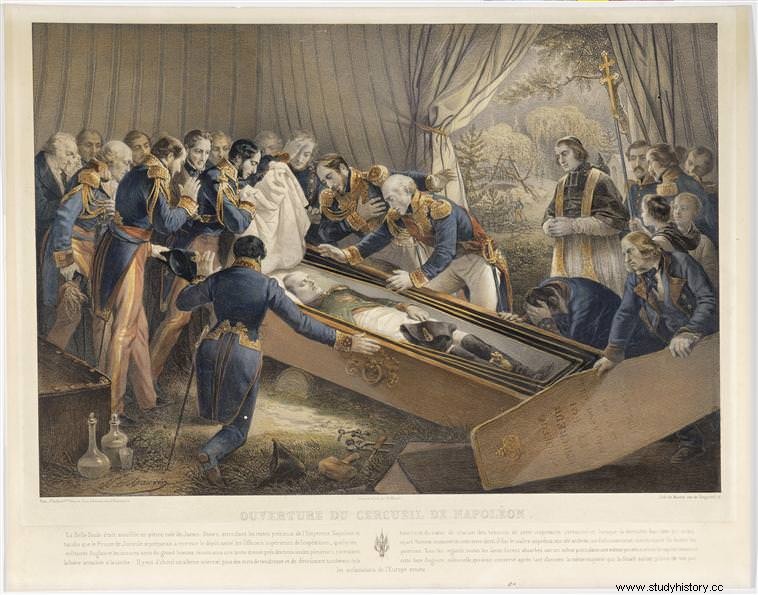
During the exhumation of the coffin and its subsequent opening, it was verified that the corpse had been kept in perfect condition, including both the uniform and the hat and the decorations , although not the boots, which had cracked revealing the toes. Transferred the body to a new coffin decorated with a golden N and the inscription:“Napoleón, Empereur, mort à Sainte-Hélène le 05 Mai 1821” (Hudson Lowe must have had a fit of rage when he found out). The structure of successive coffins, weighing 1,200 kg, was transported to the port in a solemn procession. Deposited in a zone of honor enabled in La Belle Poule, the flotilla left for France on October 18, arriving at the port of Cherbourg on November 30.
However, the political situation in France had changed from the month of May. Thiers, the promoter of the idea, had been removed from his post on October 29 due to his policy of supporting Mehmet Ali in Egypt against the interests of Great Britain, which pressed for his dismissal, willingly granted by Luis Felipe, who detested any policy that could weaken his reign, and also politicians who were too brilliant. By a twist of fate, Marshal Jean de Dieu Soult was appointed President of the Council (1769-1851) Napoleon's inept chief of staff during the Belgian campaign in 1815, who counted François Guizot (1787-1874) as a strong man in his cabinet, with whom he was linked by some interesting elements of his biographies, such as the fact of putting himself at the service of Louis XVIII after the first and second abdication of Napoleon. Therefore, it will be a government presided over by two royalists (one of origin and the other reconverted) who will have the mission of receiving the mortal remains of the Emperor, and of facing the political consequences of an event that Thiers had correctly foreseen but that now were uncomfortable for the new cabinet and the policy of conciliation that it had to undertake, especially with respect to Great Britain.
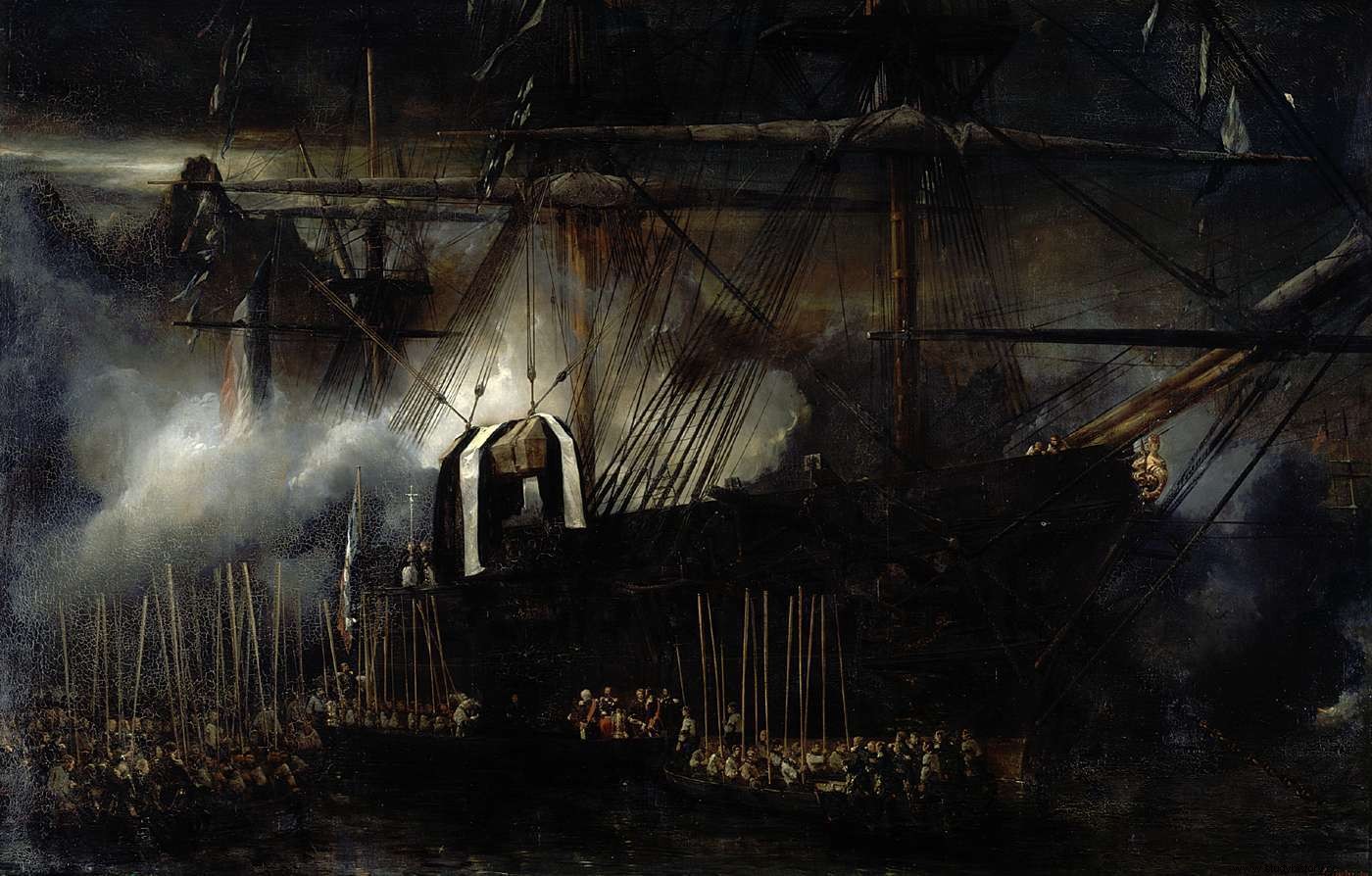
The burial had become a problem for the new government . It was decided that the ceremony would be strictly military, which provoked the first criticism from broad sectors of civil society, while the pomp devised for the transfer of the coffin angered the ambassadors of the European countries that had confronted France during the wars of the Revolution and the Empire, for which they declined to attend the ceremony and, in an act of refusal, met at the British legation in Paris to reaffirm the united front that the successive coalitions financed by Great Britain represented until they achieved the final defeat of the Emperor. Despite the fact that the preparations were not completed, the date of December 15 was set for the funeral ceremony, regardless of any complications that might arise, with the vain hope that once the transfer was completed, the possible political effervescence would subside, which would end up becoming in vain hope.
Le return des cendres
In Cherbourg, the coffin was transported to a steamship, the Normandie, which took it to the port of Le Havre to start the journey to Paris up the Seine river, which from Rouen it was carried out on a large barge, La Dorade, which will arrive at the port of Courbevoie, near Paris, on December 14. If Marshal Soult's government believed that its haste would prevent an explosion of popular support for the memory of the Emperor, it was dead wrong. Thousands of people followed the progress of the barge on the Seine from the banks, and, when the coffin was unloaded, hundreds of people demanded the right to watch over it during the night, causing some disturbances until the police authorized the night ceremony. At that time, the claimants shed their coats, revealing the ancient uniforms of the imperial army . Hundreds, even thousands of ancient grognards , excluded from the ceremony that was to take place the next day, spontaneously organized what is known as "the Emperor's last bivouac".
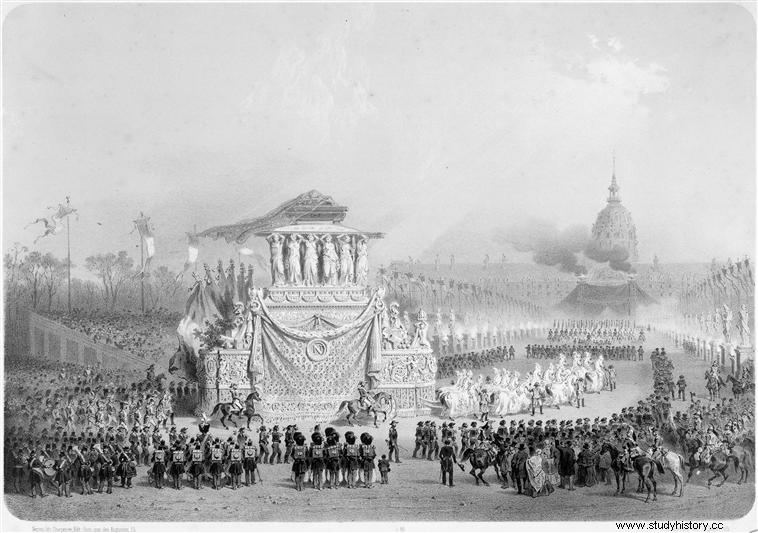
The procession left Courbevoie crossing the Pont de Neuilly to pass under the Arc de Triomphe and then head towards Los Invalides. Victor Hugo, present at the parade of the funeral procession in which a large catafalque pulled by horses veiled in black robes and the imperial arms carried the coffin, and one of the forgers of the legend through the writings he dedicated to the battle of Waterloo, especially the chapters included in his novel Les Miserables , will report that despite the low temperatures and the snowfall during part of the journey, the number of spectators that accumulated on the route was enormous, taking over all the balconies and even the roofs of the houses –it is estimated at 800,000 people. people who watched the funeral parade –, constituting the popular response the main sign of persistence among French society of what the Empire still meant, since access to the interior of the Basilica of Les Invalides, where the mortal remains will be deposited and will remain until the construction of the catafalque that contains them today would not be finished until 1861, it was restricted to the royal family and the political class, who were the least interested in a ceremony that, in the end, and as they had supposed in the month of May, became a great political error as it serves as a starting point for the comparison between the republican values consolidated during the Empire, with the increasingly conservative policies developed by the July Monarchy.
Unlike Soult, the governor of Les Invalides, Jeannott de Moncey (1754-1842), one of the less brilliant marshals of the imperial epic, but who knew how to conduct himself with dignity defending Paris in 1814 and transferring the remains of his troops to Fontainebleau to join Napoleon after Marmont's defection, and who refused pressure from Louis XVIII to preside over Marshal Ney's trial even though they did not have a good relationship, he demanded that his doctors to keep him alive so that he could receive the Emperor's remains according to his position, and, after doing so, he would comment that he could now return home to die .
Bibliography
- Bertrand, H.G.; Houdecek, F. (2021) :Les cahiers du général Bertrand . Paris:Perrin.
- Gourgaud, G.; Bourachot, Ch. (2002) :Le Retour des Cendres de l’Empereur Napoléon . Paris:Arlea.
- Lentz, Th. (2019):Bonaparte n’est plus¡. The world learned the death of Napoléon, July-September 1821 . Paris:Perrin.
- Poisson, G. (2004):L’Aventure du Retour des Cendres . Paris:Tallandier.
- Tudoret, P. (2021):La gloire et la cendre:l’ultime victoire de Napoléon . Paris:Belles Lettres.
- Feature:Napoléon n’est plus, l’exposition aux Invalides
- Report:December 15, 1840:Retour des Cendres de Napoléon
- Napoléon Bonaparte fait partie de nous . Speech by President Emmanuel Macron at the Institut de France in commemoration of the bicentenary of Napoleon's death (05/05/2021)
- Napoléon “N” Adieu . Montage of scenes from different films including the reconstruction of the Retour des Cendres in the film Monsieur N (The last battle ) by Antoine de Caunes (2003).
